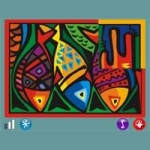
 |
Picture Blocks |
Who has an eye for detail? This game has been created with observation and concentration skills in mind. The bright and zany designs used will delight both young and old. It is a visual smorgasbord!
The game consists of a main puzzle area and a toolbar at the bottom of the screen.
| Difficulty | |
| Random puzzle changer | |
| Turn the music and sounds on and off | |
| Exit |
Each puzzle is made up of three different pictures, so therefore has three possible solutions.
Click on each picture block to turn them. The aim is to find each block of one of the pictures in that puzzle set.
When a puzzle has been successfully completed, applause will sound and another puzzle will appear.
The puzzle sets can be changed at any time by clicking on the random icon on the toolbar. The difficulty will not be changed.
The level of difficulty can be changed at any time in the game. The current puzzle set will stay the same.
Sound can be turned off and on by clicking on the sound icon on the toolbar.
To exit, click on the exit icon on the toolbar.
Outcome 4: Children are involved and confident learners
Outcome 5: Children are effective communicators
Observation
Concentration
Colours
Recognising repeated designs
Part and whole concepts
Same and different recognition
Mouse control - single click
Observation skills and the ability to concentrate are important tools in children's learning. We all know that they vary considerably between individuals and develop over time.
This game has been designed to help children to extend these skills. The designs used in the puzzles have been specifically chosen to focus on colour, repeated images and same different concepts. They are mostly abstract. In some designs colours are of similar hues. The coloured areas may be of similar size and shape. These factors all increase the level of difficulty and concentration needed to complete a puzzle.
Some puzzle sets have designs with different coloured borders. You can help children by pointing this out and suggesting that they firstly find all the edge blocks with that border colour. Some puzzle sets have the same border colour or no border at all.
The first step when tackling each puzzle is to pick a block. This will be the primary block that all other blocks in that puzzle will need to match.
The second step is to work on the blocks next to the primary one. Are the colours the same? Does the design appear to connect successfully with the first block? Does it look like both the blocks belong together? When happy that these blocks are from the same design, your child can move onto the next one, moving outwards from the primary block. Continue in this way until the design is completed.
We recommend that children start at the first level to familiarize themselves with the game before they tackle harder levels.
If a puzzle set proves too difficult, click on the random icon until an easier set of puzzles is found.